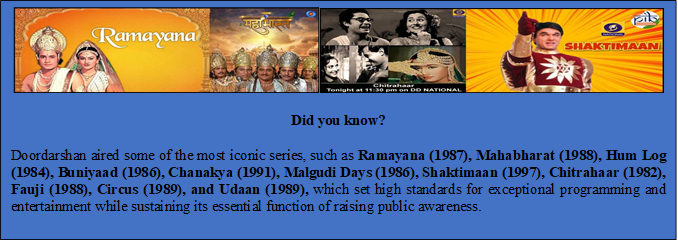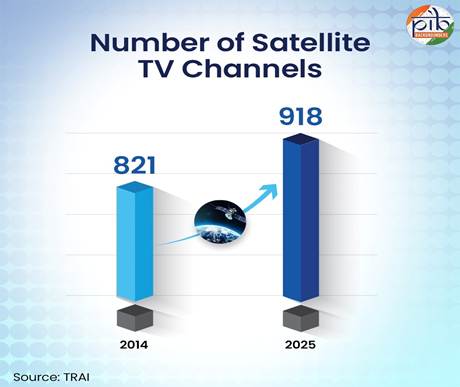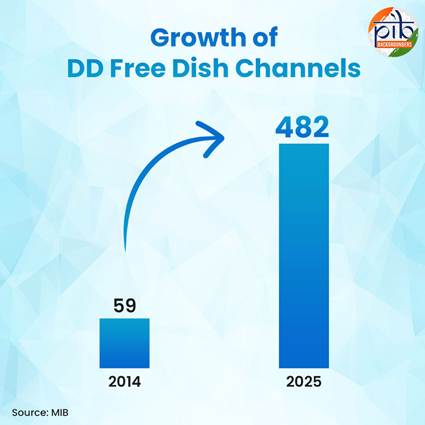PIB Headquarters
World Television Day 2025
Connecting 230 million Households Across India
Posted On:
21 NOV 2025 11:21AM by PIB Delhi
Key Takeaways
- India’s television network connects 900 million viewers across 230 million households nationwide.
- 918 private satellite channels operational as of March 2025, reflecting a vibrant broadcast ecosystem.
- 6.5 crore DD Free Dish homes, driving digital inclusion and free public access nationwide.
Introduction
World Television Day is observed globally on 21 November each year, following the proclamation of the United Nations General Assembly through a Resolution adopted in 1996. The Day recognizes television as a vital medium in informing, educating, and influencing public opinion, and in fostering communication and global understanding.
In India, where over 230 million television households reach around 900 million viewers, the Day is observed under the aegis of the Ministry of Information and Broadcasting (MIB) and its public broadcasting network, Prasar Bharati. Activities and outreach programmes by Doordarshan and All India Radio highlight television’s enduring role in public service communication, dissemination of development messages, and promotion of national integration.

Television continues to serve as one of the most powerful platforms for information and entertainment outreach in India, connecting millions of households and contributing significantly to the objectives of public awareness and participatory governance.
Did you know?
India’s Media & Entertainment (M&E) sector contributed ₹2.5 trillion to the economy in 2024 and is projected to exceed ₹3 trillion by 2027. The television and broadcasting segment alone generated nearly ₹680 billion in 2024. The sector’s growth is driven by digital expansion, 4K broadcasting, Smart TVs, 5G, and OTT platforms serving over 600 million users.
|
Growth of television in India
Television in India has evolved from a limited experimental service to one of the world’s largest broadcasting networks, reflecting the country’s progress in communication technology, public outreach, and digital innovation. Guided by the Ministry of Information and Broadcasting, India’s television journey mirrors the nation’s socio-economic development—from community education broadcasts in the 1950s to a fully digitised, multi-channel environment today. The following phases trace this transformation, highlighting key policy milestones and technological advancements documented in official records.
Experimental and Foundational Phase (1959–1965)
Television broadcasting in India began on an experimental basis on 15 September 1959, initiated by All India Radio (AIR) under the Ministry of Information and Broadcasting (MIB). The service was launched in collaboration with UNESCO to explore television’s role in education and community development. Initially, broadcasts were limited to a small radius around Delhi, with programmes focusing on school education and rural upliftment.
Expansion and Institutionalisation (1965-1982)
Regular daily transmission began in 1965, marking the establishment of Doordarshan as a dedicated television service within All India Radio (AIR). During this period, television rapidly transitioned from a limited experiment into a growing public service medium. New television centres were set up across major cities, including Mumbai (1972), Srinagar, Amritsar, and Calcutta (1973–75), and Chennai (1975), expanding coverage and strengthening the national broadcast infrastructure. Doordarshan emerged as one of the key aspects in the broadcasting landscape in India, reflecting the rapid expansion of television as a national medium during this period.

A landmark development of this era was the Satellite Instructional Television Experiment (SITE) conducted in 1975–76 by ISRO and NASA, one of the world’s largest satellite-based education experiments. Under SITE, NASA’s ATS-6 satellite enabled direct broadcast of educational content to around 2,400 villages across 20 districts in six states, while ISRO provided ground systems and AIR managed programme production. Programmes focused on agriculture, health, family planning, primary education, and teacher training — laying the foundation for satellite-based development communication in India.
Doordarshan expanded its mandate beyond entertainment into news, public service broadcasting, community learning, and educational outreach. The network began structured broadcasts in school education, rural development, and awareness generation, setting the stage for future national initiatives such as UGC’s higher-education telecasts and CEC’s curriculum-based programming.
This period also marked Doordarshan’s growing role in delivering authentic, balanced news and public information across the country, as public broadcasting evolved beyond entertainment into a tool for social development. Regional Doordarshan Kendras strengthened local-language content creation, enabling broader representation of India’s cultural and linguistic diversity. With the expansion of television centres and regional production units, Doordarshan strengthened local-language content creation and broadened cultural representation.
By the early 1980s, the institutional foundations of Indian television were firmly established — a nationwide network, a development-oriented programming ethos, and growing technological capability that would drive the next phase of expansion, including colour broadcasting and national coverage.

Colour Television and National Coverage (1982–1990)
The introduction of colour television in 1982, coinciding with the Asian Games in New Delhi, was a landmark in India’s broadcasting history. This period saw rapid expansion of terrestrial transmitters under Doordarshan, extending reach to rural and remote areas. By 1990, Doordarshan’s network covered nearly 70% of India’s population and 80% of the geographical area. During the 1980s, Doordarshan also expanded the role of its regional broadcasting centres—known as Doordarshan Kendras—which produce and transmit programmes in regional languages, thereby strengthening linguistic and cultural diversity in national broadcasting.
Liberalisation and Satellite Era (1991–2011)
With the economic liberalisation of the early 1990s, India’s television landscape opened to private satellite broadcasters. Early private channels included Star TV (1991), Zee TV (1992) and Sony Entertainment Television (1995), which introduced new formats in entertainment, film, music, and news programming and marked the beginning of a multi-channel satellite television ecosystem.
During this period, Doordarshan expanded and diversified its national and regional network. Channels such as DD National, DD Metro, DD News, DD India, and several DD Kendras (state broadcasting centres operated by Doordarshan) continued to deliver public-service broadcasting and regional-language content, ensuring nationwide access as private networks grew.
India also transitioned to digital satellite broadcasting during this era. A major milestone was the launch of DD Direct Plus in December 2004, India’s first free-to-air Direct-to-Home (DTH) service, which significantly expanded access to television in rural and remote regions.
Did you know?
The Prasar Bharati Act, 1990 was enacted to establish an autonomous public service broadcaster for India. The Act came into full effect on 23 November 1997, leading to the formation of the Prasar Bharati Corporation.
With its operationalisation, Doordarshan and All India Radio were brought under the corporation as its two primary constituent broadcasters. The Act mandates Prasar Bharati to function independently and impartially, ensuring diverse broadcasting that serves the public interest.
|
Digitisation and Modern Broadcasting Phase (2012–Present)
The Government of India implemented Cable TV Digitisation in four phases between 2012 and 2017, under the Cable Television Networks (Regulation) Act, 1995, ensuring improved signal quality and viewer choice. Prasar Bharati’s DD Free Dish, India’s only free-to-air DTH service, emerged as a major vehicle for digital inclusion, reaching nearly 50 million households as of 2024. Today, India’s vast television network serves hundreds of millions of viewers nationwide, making television the country’s most accessible mass communication platform and connecting urban and rural audiences alike.

Educational initiatives
Television has long been a vital medium for education in India, leveraging its extensive reach to promote inclusive learning and bridge gaps in access to knowledge. Public broadcasting, particularly through Doordarshan and DD Free Dish, has played a central role in extending curriculum-aligned lessons, skill development programmes, and teacher training resources to learners across the country, including those in rural, remote, and underserved regions. Over the decades, government-led initiatives have increasingly integrated traditional broadcast with digital platforms, creating a hybrid learning ecosystem that combines accessibility, quality content, and pedagogical effectiveness.
Educational Broadcasting During COVID-19
During the COVID-19 pandemic, Doordarshan emerged as a vital platform for when schools and universities were closed, Doordarshan played an important role in supporting continuity of learning. The Ministry of Education (MoE), in coordination with the Ministry of Information and Broadcasting (MIB) and Prasar Bharati, rapidly scaled up televised learning solutions so that students without internet access were not left behind. Doordarshan’s national and regional channels broadcast curriculum-aligned lessons, teacher-led sessions, and subject-specific content, reaching millions of learners in rural and remote areas.
PM e-Vidya Initiative
Under the Government’s digital education response, the PM e-Vidya programme, a comprehensive initiative to consolidate digital, online, and broadcast-based education resources, was launched to unify and streamline all digital and broadcast-based modes of learning across the country. A key component of this initiative is the “One Class – One Channel” scheme, which introduced 12 dedicated DTH television channels (Classes I–XII) through the SWAYAM Prabha platform, delivering curriculum-based content prepared by NCERT and partner institutions. These channels are accessible through Doordarshan’s DTH services (including DD Free Dish), other free-to-air satellite platforms, and regional Doordarshan channels that supplement national content with state-specific educational programming.
The initiative integrates televised learning with digital repositories such as SWAYAM, DIKSHA, and NCERT resources. It ensures broad, equitable access—particularly for students without reliable internet—aligning strongly with the principles of the National Education Policy (NEP) 2020.
|
Did you know?
Study Webs of Active‑Learning for Young Aspiring Minds (SWAYAM): India’s national platform for online courses (MOOCs) across school, higher education, and skill development. Offers curriculum-based courses from IITs, UGC, NCERT, and other national institutions.
Digital Infrastructure for Knowledge Sharing (DIKSHA): A government learning platform supporting school curricula, teacher training, assessments, and multi-lingual digital content. Enables offline and online access for students and educators.
NCERT Digital Content Repositories – Provides textbooks, e-resources, and interactive learning material aligned with the national curriculum.
|
PM e-Vidya programme provided:
- 12 dedicated DTH television channels for school education (one for each class from 1 to 12),
- Integration with SWAYAM, DIKSHA, and NCERT digital content repositories, and
- Broadcast access through Doordarshan National and regional channels to reach learners without internet connectivity.
Together, these efforts underscore the Government’s commitment to using public service broadcasting as a tool for inclusive learning and digital empowerment.
SWAYAM Prabha Educational Channels
Complementing PM e-Vidya, the SWAYAM Prabha initiative operates a set of high-quality educational TV channels that broadcast curriculum-based content 24×7 through GSAT satellites.
Key features include:
- Channels dedicated to higher education, school education, teacher training, and skill development
- Content developed by IITs, UGC, CEC, IGNOU, NCERT, NIOS, and other national institutions
- Continuous telecasts with repeat slots to maximise flexibility
- Availability across DTH platforms, including DD Free Dish
This system ensures that both school and higher-education learners have uninterrupted access to academic content, further strengthening India’s blended learning ecosystem.
Viewership and Socio-Economic Impact
Television remains the most widely accessed medium in India, with a strong penetration of satellite and broadcast channels. As of 31 March 2025, the Ministry of Information and Broadcasting (MIB) had permitted 918 private satellite TV channels (for uplinking, downlinking or both) in India. Out of these, 908 channels were available for down‑linking in India, of which 333 were pay TV channels (232 SD + 101 HD).
SD channels provide video at lower resolution and bandwidth, while HD channels offer significantly higher picture clarity and detail due to increased resolution, which enhances the viewing experience, especially on larger screens. The growth in channel numbers from 821 in 2014 to 918 in 2025 underscores how television continues to be an important cultural and informational medium across linguistic regions.

Television also has significant socio-economic impacts: it provides employment across content creation, broadcasting operations, and regulatory compliance; supports livelihoods in production and distribution; and enables access to education, health, and government schemes for rural and semi-urban populations. Television’s extensive reach, linguistic diversity, and regulatory oversight underline its continuing importance as both a cultural and economic driver in India’s media landscape.
Technology and Innovation in Indian Television
The television broadcasting ecosystem is undergoing a major transformation through digital infrastructure upgrades, technological innovations, and regulatory reforms—driven by government policy and initiatives from the public broadcaster, Prasar Bharati.
Terrestrial Transition and Infrastructure Modernisation
India’s transition from analogue to digital terrestrial transmission (DTT) has gathered momentum in recent years. Analogue terrestrial transmitters historically covered about 88% of the population, but the system had inherent limitations, including restricted channel capacity and lower picture and sound quality.
What is Digital Terrestrial Television (DTT)?
DTT transmits television signals digitally through terrestrial broadcast towers, replacing traditional analogue transmission. It enables multiple channels, sharper picture quality, and mobile reception without cable or satellite links.
|
Digital terrestrial transmission offers more efficient use of spectrum and better signal clarity. India’s DTT network uses the DVB-T2 (Digital Video Broadcasting – Second Generation Terrestrial) standard, which allows multiple TV channels to be broadcast on a single frequency with improved reception, including in mobile or indoor environments. The first DVB-T2 digital transmitters were commissioned in 16 cities in February 2016, with long-term plans to expand the digital network to 630 locations across the country.
Nearly all analogue terrestrial transmitters of Doordarshan have been phased out, except at around 50 strategic locations. These remaining sites—primarily in border, remote, or sensitive regions—ensure reliable television coverage where DTH or cable connectivity may still be limited. Keeping a limited analogue footprint also supports service continuity during the transition to full digital operations, while the wider phase-out frees valuable spectrum that can be repurposed for modern communication technologies such as 5G broadcast services.
Expanding Access via Public Free-to-Air DTH
To reach households without cable or terrestrial connections, particularly in remote, border, and tribal areas, Prasar Bharati’s DD Free Dish has been significantly expanded. Official estimates indicate that over 6.5 crore households currently access this free-to-air DTH service. The platform accommodates both MPEG‑2 and MPEG‑4 slots and invites private TV channels through e‑auction allocation, reflecting an inclusive approach to technological adoption and content diversity.
What is MPEG?
MPEG (Moving Picture Experts Group) refers to global standards for digital video compression.
- MPEG-2 is used for standard-definition (SD) broadcasts on older set-top boxes.
- MPEG-4 offers higher efficiency and quality, supporting high-definition (HD) services.
- DD Free Dish uses both formats to ensure compatibility across devices and expand channel capacity.
|
Since its inception, DD Free Dish has seen remarkable growth in channel capacity—rising from 59 channels in 2014 to 482 channels in 2025, expanding access to a wide range of national, regional, and educational content across the country.
DD Free Dish continues to play a key role in expanding television access across India, particularly in remote, border, and underserved regions. As a free-to-air Direct-to-Home (DTH) platform, it complements Doordarshan’s digital terrestrial network by providing reliable access to national, regional, and educational content. Its inclusive model ensures that even households without cable or internet connectivity can benefit from the country’s evolving broadcast infrastructure.

Evolving Regulatory Frameworks and Authorisation Reforms
India’s regulatory landscape is adapting to the convergence of broadcasting platforms. The Telecom Regulatory Authority of India (TRAI) issued recommendations on the “Framework for Service Authorisations for Broadcasting Services under the Telecommunications Act, 2023,” updating operational and licensing requirements to align with the new legislative regime.
These reforms reflect the government’s intent to support multi-platform distribution, integrate OTT services, and ensure quality of service, accessibility, and market oversight across India’s broadcasting ecosystem.
Conclusion
India’s television ecosystem has entered a new era of digital transformation—driven by technological innovation, multilingual content, and inclusive access. Modern broadcasting advancements such as high-definition and satellite expansion, alongside emerging AI-enabled tools, are already enabling regional language content creation, real-time subtitling, and interactive programming. These developments ensure television continues to be a truly inclusive medium—bridging linguistic, cultural, and digital divides across the nation.
Supported by government-led initiatives in digital infrastructure, public service broadcasting, and content innovation, television is evolving from a one-way communication channel into a participatory platform that reflects India’s diverse voices. From its modest beginnings in 1959 to connecting over 900 million viewers today, the medium stands as both a mirror and a messenger of India’s progress. It continues to promote awareness, foster inclusion, and shape a connected, informed, and empowered India, reinforcing its enduring role as a cornerstone of national communication.
References
Press Information Bureau
https://www.education.gov.in/sites/upload_files/mhrd/files/document-reports/AnnualReport2020-21.pdf
https://www.education.gov.in/sites/upload_files/mhrd/files/document-reports/AnnualReport2020-21.pdf
https://www.education.gov.in/en/nep/aqeg-se
https://trai.gov.in/sites/default/files/2025-07/YIR_08072025_0.pdf
https://prasarbharati.gov.in/digital-terrestrial-tv
https://prasarbharati.gov.in/wp-content/uploads/2024/04/PressRelease-1762343.pdf
https://trai.gov.in/sites/default/files/2024-09/CP_08082023_0.pdf
https://prasarbharati.gov.in/free-dish/
https://trai.gov.in/sites/default/files/2025-02/PR_No.13of2025.pdf
https://www.pib.gov.in/PressReleasePage.aspx?PRID=1623841
https://mib.gov.in/flipbook/93
https://www.pib.gov.in/PressReleseDetail.aspx?PRID=2141914
https://www.isro.gov.in/genesis.html
https://prasarbharati.gov.in/free-dish
https://www.swayamprabha.gov.in/about/pmevidya
https://www.pib.gov.in/PressReleasePage.aspx?PRID=2176179
Click here to see PDF
SA
(Release ID: 2192398)
Visitor Counter : 705